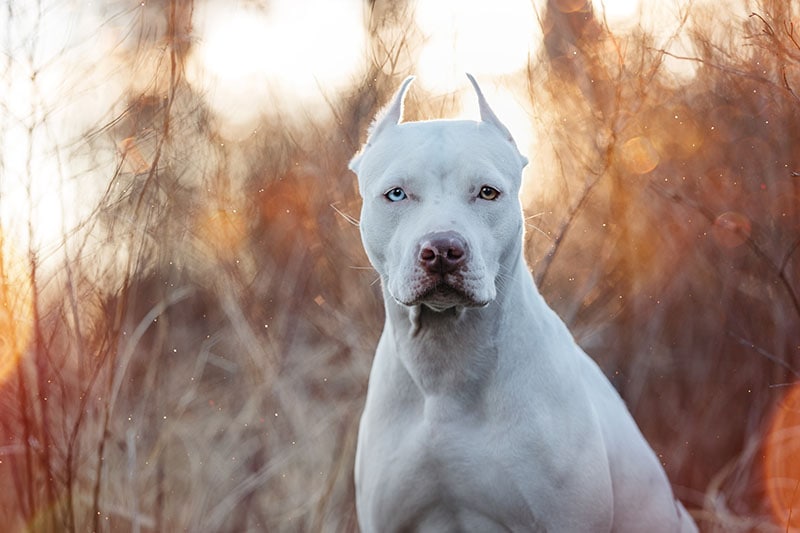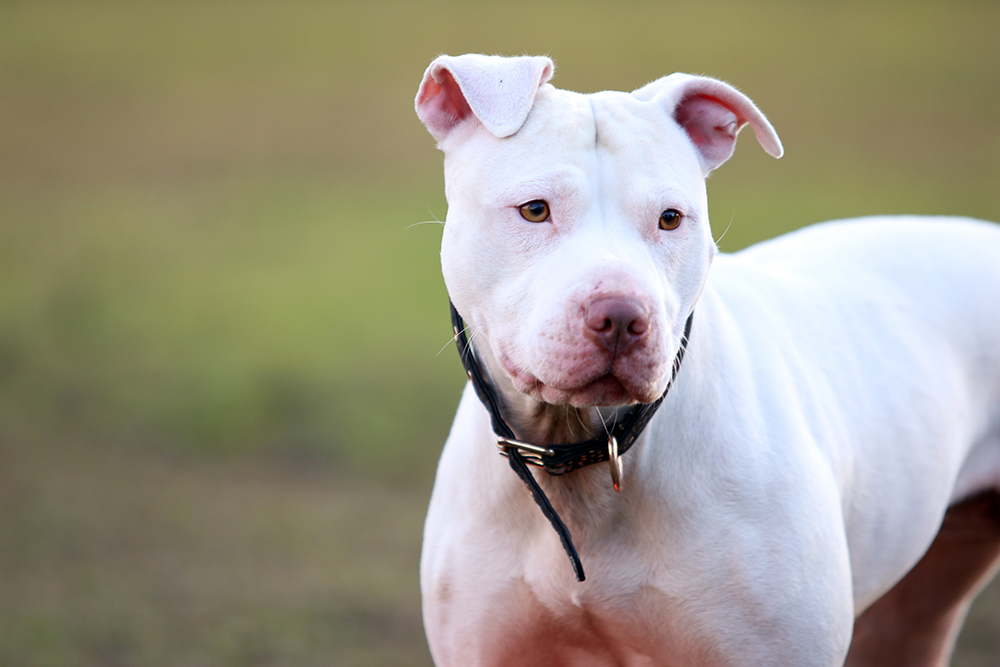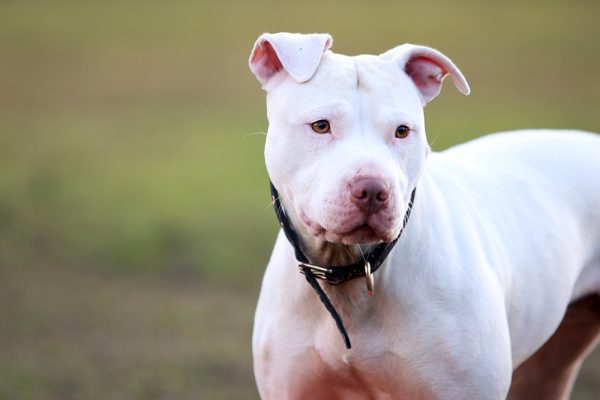Click to Skip Ahead
They might be a popular family pet now, but the Pitbull has a troubled origin. Loyal and loving but guarded with others, Pitbulls are a stocky, athletic breed happy to play fetch in the yard or cuddle on the couch after a long day. They make lovely companions for kids, with ample socialization and training, of course. They get a bad rap for aggression and a stubborn streak, but in truth, Pitbulls are one of the most adoring dog breeds you can welcome into your home.
Breed Overview
Height:
17–19 inches
Weight:
40–70 pounds
Lifespan:
12–15 years
Colors:
White, minor markings in other colors including black, gray, and brown
Suitable for:
Active households with or without kids
Temperament:
Devoted, affectionate, athletic, reserved toward strangers
White Pitbulls have a snowy white coat that may be seamless or with minor markings. This color is considered rare because it only happens due to genetic mutations like albinism, the merle gene, or the piebald gene. Depending on which gene, they may have an all-white coat or a spotted coat with either light or dark eyes. Regardless of their appearance, white Pitbulls tend to share the same doting, sometimes possessive, nature.
White Pitbulls Characteristics
The Earliest Records of White Pitbulls in History
The American Pit Bull Terrier, also called the Pitbull or just Pit, started in the 1800s as a way to cross the now-extinct Old English Terrier with the Old English Bulldog. Sadly, the purpose was to breed a more agile terrier crossbreed for baiting bears and bulls that still had the Old English Bulldog’s strength and tenacity.
It was in these early days that the Pitbull got the “Pit” in its name, too. They would be literally trapped in literal pits with rats, bulls, and bears as a bloodsport that made a lot of money from gambling. After baiting was outlawed in England, Pitbulls were mostly either used as rat catchers or in dog fighting.
White Pitbulls specifically were uncommon then as they are today, and some spurious sources claim the white coloring makes them a different species altogether.

How Pitbulls Gained Popularity
After their debut as fighting dogs, Pitbulls were taken by immigrants to the US, where they had a mixed reputation. On one hand, they were heavily associated with criminal dogfighting and gambling, but on the other hand, they made fantastic family companions and playmates for children with enough socialization. They were wildly popular and were briefly considered an “All-American” breed before falling out of favor again.
Today, Pitbulls still carry a heavy stigma from the actions of cruel breeders, but a lot of work is being done to rehabilitate their image. Despite their past, Pitbulls today are mostly companions and working dogs. They also make excellent watchdogs because of their intimidating bark and territorial instincts.
Formal Recognition of White Pitbull
Pitbulls still aren’t formally recognized by the AKC, but they were first formally recognized by the United Kennel Club way back in 1898. Pitbulls aren’t AKC recognized because they’re technically a crossbreed with no clearly defined breed standards, but it’s likely the breed’s association with dogfighting and other illicit activities doesn’t help the matter.
Most importantly, white Pitbulls aren’t UKC recognized because the coloration is considered a disqualifying factor according to established breed standards. This applies to albino, merle, and piebald Pitbulls.
Top 8 Unique Facts About the White Pitbull
1. It’s All Because of Albinism
White Pitbulls with albinism have a complete lack of melanin in their skin, manifesting in an all-white coat with light eyes.
2. Parents Are Also an Influence
Like other recessive traits, Pitbulls with white coats are more common when both parents are also white.
3. There is a Difference Between Merle and Albinos
Merle Pitbulls differ from albinos in that they don’t have a complete lack of melanin but muted black markings that look gray or blueish.
4. The Eyes Are Also Influenced.
White Pitbulls with albinism and the merle coloring always have light-colored eyes.
5. They Are More Prone to Deafness
White Pitbulls of all types are more prone to deafness than regular-colored Pitbulls.
6. Heterochromia is More Common
Heterochromia, or having different-colored eyes, is more common in white Pitbulls.
7. They Are More Vulnerable to Sun
Because there’s less melanin in their skin, white Pitbulls are more vulnerable to the sun’s UV radiation than other colors of Pitbull.
8. They Are Rare and Expensive
Despite being considered “deficient” by breed standards, white Pitbulls are rare and may command higher prices than normal colored Pits.

Do White Pitbulls Make a Good Pet?
Yes, white Pitbulls make a great family pet for active households, and their reputation as a “nanny dog” is well-earned—they’re especially great when raised alongside kids. Despite a pigheaded reputation and their standoffish attitude toward strangers, Pitbulls are bright, emotional animals that thrive with lots of love and some patience. They might get rowdy sometimes, but that goofy, drooly grin and their enthusiastic doggy kisses are worth all the trouble.
We must note that Pitbulls require a lot of socialization and firm boundaries to curb bad behavior, especially if you have children. Ideally, we recommend them for experienced dog owners, but with enough patience, anyone can have a lovely white Pitbull.
Finally, anyone aspiring to own a white Pitbull should first check their community or local laws. Some places prohibit Pitbulls and other dog breeds deemed potentially aggressive.
Conclusion
White Pitbulls have an uncommonly striking coat because of mutated genes, but their appearance may vary based on whether they’re albino, merle, or piebald. Besides that, white Pitbulls are dependable, quirky, and goofy screwballs who bond strongly with their family.
See also:
- 12 Dog Anxiety Treatments Approved by Our Vet
- Why Does My Dog Chatter Its Teeth? 8 Vet-Verified Reasons
Featured Image Credit: Chris Anabalon, Shutterstock











